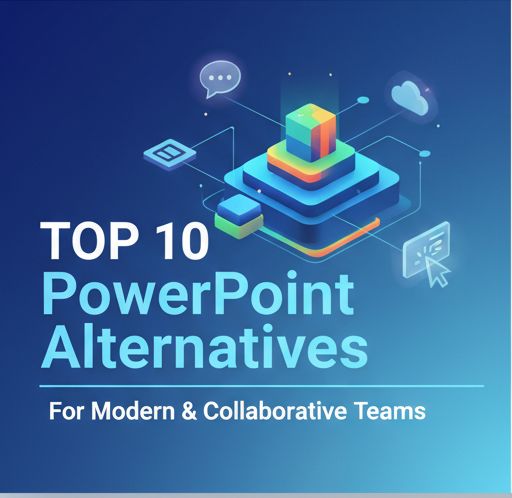For decades, Microsoft PowerPoint has been the undisputed king of presentation software. However, the modern workplace is evolving rapidly, demanding tools that prioritize real-time collaboration, cloud accessibility, and dynamic visual storytelling over static slide decks. While PowerPoint remains powerful, its limitations in team-based environments, especially those embracing remote or hybrid work models, are becoming increasingly apparent. This shift isn’t just about aesthetics; it’s about workflow efficiency and ensuring everyone contributes seamlessly to the final product.
The rise of cloud-native platforms has fundamentally changed how teams create and share information. Today’s presentation tools need to integrate effortlessly with other project management software, offer robust version control, and allow multiple users to edit simultaneously without the headache of merging files. If your team is still emailing .pptx files back and forth, you’re likely losing valuable time and risking version confusion. It’s time to explore the vibrant ecosystem of alternatives designed specifically for the agility of modern teamwork.
This article dives into the top ten PowerPoint alternatives that cater specifically to the needs of collaborative, forward-thinking teams. We’ll look at tools that blend powerful presentation features with the seamless sharing and feedback mechanisms necessary for success in today’s fast-paced business environment. Whether you prioritize sleek design, deep integration, or pure collaborative power, there’s a modern solution waiting to streamline your next big pitch.
Beyond PowerPoint: Best Options Now
The first tier of excellent PowerPoint alternatives focuses on providing a familiar yet significantly enhanced presentation creation experience. These tools often boast intuitive interfaces, making the transition from traditional software relatively painless, while immediately boosting capabilities in areas like cloud storage and cross-platform access. They are the direct successors, offering robust feature sets for those who still need deep control over slide formatting and animation, but within a more flexible framework.
Google Slides stands out as the immediate challenger in this space, primarily due to its unparalleled accessibility and native integration within the Google Workspace ecosystem. Its real-time co-editing capabilities set the standard, allowing multiple colleagues to work on the same presentation simultaneously, seeing each other’s cursors move and changes appear instantly. This functionality alone drastically cuts down on revision cycles that plague traditional desktop software users.
Beyond the established giants, tools like Prezi offer a fundamentally different approach to presentation structure. Instead of linear slides, Prezi utilizes a dynamic, zooming canvas that allows presenters to show relationships between concepts visually, which can be far more engaging for complex narratives. For teams looking for robust, professional-grade desktop software that still plays well with the cloud, alternatives like Apple Keynote (especially for Mac-heavy teams) offer stunning visual fidelity and performance that rivals, and sometimes surpasses, Microsoft’s offering.
Collaborative Tools That Shine Bright
The true differentiation in modern presentation software lies in how well they facilitate teamwork during the creation process, not just during the final delivery. Tools focusing heavily on collaboration often integrate features that go beyond simple simultaneous editing, incorporating project management elements directly into the presentation flow. This means tying feedback directly to specific slides or sections, ensuring context is never lost when reviewing drafts.
Platforms such as Visme and Canva have brilliantly merged presentation creation with broader graphic design and content marketing capabilities. They are ideal for teams where the presentation isn’t just a report, but a crucial piece of marketing collateral. These tools excel because they provide vast libraries of professional templates, stock assets, and brand kits, ensuring visual consistency across all team members’ contributions without needing a dedicated designer for every deck.
Finally, the future of collaboration often involves embedding presentations within larger workflows. Tools that integrate with Slack, Asana, or specialized knowledge bases make presentations feel less like isolated documents and more like living parts of a company’s shared intelligence. By choosing alternatives that emphasize these integration points, teams ensure that their presentation materials are easily discoverable, constantly up-to-date, and accessible right where the work is happening, truly modernizing the presentation lifecycle.
TOP 10 POWERPOINT ALTERNATIVES FOR MODERN & COLLABORATIVE TEAMS
| Rank | Alternative | Best For | Key Differentiator |
|---|---|---|---|
| 1 | Google Slides | Real-time team editing & Google Workspace users | Unmatched native co-authoring experience. |
| 2 | Canva Presentations | Design-focused teams & marketing collateral | Massive, accessible library of templates and assets. |
| 3 | Prezi | Dynamic, non-linear storytelling & high engagement | Zooming canvas structure keeps audiences focused. |
| 4 | Visme | Infographics, data visualization, and business reports | Excellent for turning complex data into visual stories. |
| 5 | Apple Keynote | Mac-centric teams prioritizing polish and performance | Superior animations and fluid transitions on Apple devices. |
| 6 | Beautiful.ai | Speed and design automation | AI-powered designer enforces brand consistency instantly. |
| 7 | Tome | AI-assisted storytelling and mobile-first delivery | Uses AI to generate initial layouts and content drafts. |
| 8 | Zoho Show | Teams heavily invested in the Zoho ecosystem | Deep integration with Zoho CRM and other business apps. |
| 9 | Pitch | Pitch decks, sales enablement, and modern aesthetics | Focuses on beautiful, shareable, and trackable decks. |
| 10 | Slidebean | Startups requiring professional pitch decks quickly | Specialized templates designed by venture capitalists. |
The decision to move beyond PowerPoint doesn’t mean abandoning high-quality presentations; it means embracing tools built for how modern teams actually work. The alternatives listed above offer significant advantages, whether you need the bulletproof collaboration of Google Slides, the design prowess of Canva, or the dynamic structuring of Prezi. By adopting one of these platforms, your team gains efficiency, ensures visual cohesion, and ultimately creates more engaging and impactful presentations.
The key takeaway for any organization looking to upgrade its presentation workflow is to prioritize integration and real-time functionality. Static files belong in the archives; dynamic, cloud-based documents belong in your active toolset. Evaluate your team’s specific needs—is it speed, design, or deep data visualization?—and select the alternative that best supports that core function.
Ultimately, the best presentation tool is the one that gets out of your creative way while keeping everyone on the same page. By making the switch to a modern, collaborative alternative, you are investing directly in smoother workflows and more successful outcomes for your next major presentation.


